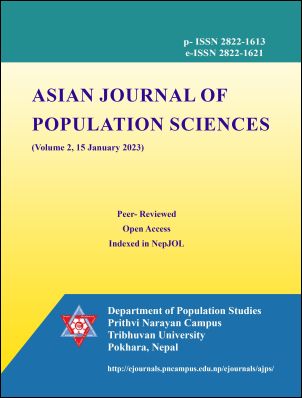Effect of Women’s Status in Fertility Transition of Nepal
DOI:
https://doi.org/10.3126/ajps.v2i1.51095Keywords:
Fertility, age at marriage, literacy, value of children, health facilitiesAbstract
Assessing the relationship of fertility transition with different socio-economic situation of women is the overall purpose of this study. Fertility is primarily natural demographic determinant; however, it is affected by different social, economic and demographic phenomena. This study aimed to assess the changing fertility pattern (TFR and CBR) relating to the socioeconomic and demographic status of women in case of Nepal. Literacy status, health services, employment pattern, age at marriage, foreign migration (social determinants of population change) inequality aspects of women are considered as the socioeconomic and demographic aspects determines the pace of change of fertility rate and measured by the linear regression equation and multiple regression analysis. Quantitative and descriptive analysis is used to demonstrate the relationship examined and assessed through secondary data. The output of the statistical test is found that there is strong negative relationship (more than -0.90) with more than 80 per cent of explaining variability of fertility rate of Nepal by these independent (socioeconomic and demographic) variables. Finally, as literacy rate, age at marriage, economically activeness, life expectancy of female are found in increasing pattern with advancement of Nepalese society, CBR and TFR both are found in decreasing trends along with reduction on gender inequality.
Downloads
Downloads
Published
How to Cite
Issue
Section
License
Copyright (c) 2023 Kedar Satyal

This work is licensed under a Creative Commons Attribution-ShareAlike 4.0 International License.




